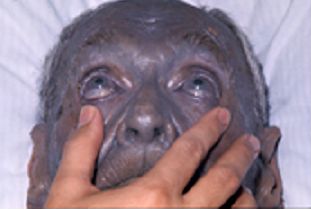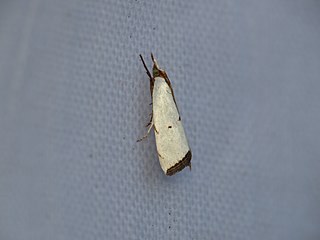
Argyria or argyrosis is a condition caused by excessive exposure to chemical compounds of the element silver, or to silver dust. The most dramatic symptom of argyria is that the skin turns blue or blue-grey. It may take the form of generalized argyria or local argyria. Generalized argyria affects large areas over much of the visible surface of the body. Local argyria shows in limited regions of the body, such as patches of skin, parts of the mucous membrane or the conjunctiva.
Vaxi is a genus of moths of the family Crambidae.

Hypsoropha is a genus of moths of the family Erebidae. The genus was erected by Jacob Hübner in 1818.

North Toowoomba is an urban locality in Toowoomba in the Toowoomba Region, Queensland, Australia. In the 2016 census, North Toowoomba had a population of 2,953 people.

Chrysendeton medicinalis, the bold medicine moth, is a moth in the family Crambidae. It was described by Augustus Radcliffe Grote in 1881. It is found on North America, where it has been recorded from Alabama, Florida, Georgia, Illinois, Indiana, Kentucky, Maryland, Mississippi, North Carolina, Ohio, Pennsylvania, South Carolina, Tennessee, Texas and West Virginia.
Eoparargyractis floridalis is a moth in the family Crambidae. It was described by William Harry Lange in 1956. It is found in North America, where it has been recorded from Florida and South Carolina.

Vaxi auratellus, the curve-lined vaxi or curve-lined argyria moth, is a moth in the family Crambidae. It was described by James Brackenridge Clemens in 1860. It is found in North America, where it has been recorded from the eastern United States and south-eastern Canada from Quebec and Maine to Florida, west to Texas and north to Manitoba. It is also found in California. The habitat consists of wet prairies and meadows.

Argyria lacteella, the milky urola moth, is a moth in the family Crambidae. It was described by Johan Christian Fabricius in 1794. It is found in North America, from Maryland south to Florida and west to Texas. In the south, the range extends through Costa Rica to Brazil. It is also found on Cuba, Puerto Rico and Bermuda.

Argyria nummulalis is a moth in the family Crambidae. It was described by Jacob Hübner in 1818. It is found in North America, where it has been recorded from Alabama, Florida, Georgia, Kansas, Maryland, Massachusetts, Mississippi, North Carolina, Pennsylvania and South Carolina.

Argyria rufisignella, the mother-of-pearl moth, is a moth in the family Crambidae. It was described by Zeller in 1872. It is found in North America, where it has been recorded from the eastern United States and in the south to Arizona.
Argyria subaenescens is a moth in the family Crambidae. It was described by Francis Walker in 1863. It is found in North America, where it has been recorded from Illinois.
Argyria tripsacas is a moth in the family Crambidae. It was described by Harrison Gray Dyar Jr. in 1921. It is found in North America, where it has been recorded from Florida and Alabama. It is also present on the West Indies. The habitat consists of coastal dunes.
Loxocrambus canellus is a moth in the family Crambidae. It was described by William Trowbridge Merrifield Forbes in 1920. It is found in North America, where it has been recorded from Florida, Mississippi and Texas.
Loxocrambus mohaviellus is a moth in the family Crambidae. It was described by William Trowbridge Merrifield Forbes in 1920. It is found in North America, where it has been recorded from California.

Microcrambus biguttellus, the gold-stripe grass-veneer, is a moth in the family Crambidae. It was described by William Trowbridge Merrifield Forbes in 1920. It is found in North America, where it has been recorded from Alabama, Florida, Georgia, Illinois, Indiana, Kentucky, Maine, Manitoba, Maryland, Massachusetts, Michigan, Minnesota, Mississippi, New Brunswick, New Jersey, New York, North Carolina, Nova Scotia, Ohio, Oklahoma, Ontario, Quebec, South Carolina, Tennessee, Texas, West Virginia and Wisconsin. It has also been recorded from Cuba and Puerto Rico.
Microcrambus minor is a moth in the family Crambidae. It was described by William Trowbridge Merrifield Forbes in 1920. It is found in North America, where it has been recorded from Alabama, Florida, Illinois, Indiana, Manitoba, Maryland, Massachusetts, Minnesota, Mississippi, New Hampshire, New York, North Carolina, Ohio, Oklahoma, Ontario, Pennsylvania, Quebec, South Carolina, Tennessee, West Virginia, Virginia, and Wisconsin.

Diastictis argyralis, the white-spotted orange moth, is a moth in the family Crambidae. It was described by Jacob Hübner in 1818. It is found in North America, where it has been recorded from Colorado, Florida, Georgia, Indiana, Maine, Maryland, Mississippi, North Carolina, Ohio, Ontario, South Carolina, Tennessee, Texas and Virginia.

Pilocrocis ramentalis, the scraped pilocrocis moth, is a moth in the family Crambidae. It was described by Julius Lederer in 1863. It is found in North America, where it has been recorded from Ontario to Florida and from Wisconsin to Texas. It is also found in Mexico, Honduras, Costa Rica, Cuba and Puerto Rico. It is an introduced species on the Galápagos Islands. The habitat consists of open woods, clearings and damp areas.
Sufetula carbonalis is a moth species in the family Crambidae. It was described by James E. Hayden in 2013. It is found in North America, where it has been recorded from Florida.











